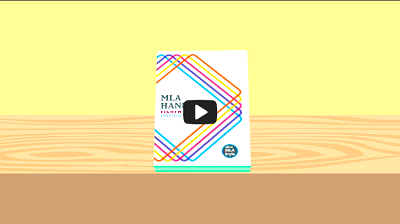MLA (Modern Language Association) format is most commonly used to cite sources in the humanities. The following examples use MLA 9th edition.

Video: MLA 9th Edition Citation Style
Pause or complete the video before closing. Otherwise it will keep playing.
MLA format uses a parenthetical citation, which is a brief mention in the text of your paper that leads the reader to the complete information about that reference. It usually appears at the end of a sentence. A parenthetical citation involves placing relevant source information in parentheses after a quote or a paraphrase. The author’s last name and the page number(s) from which the quotation or paraphrase is taken must appear in the text, and a complete reference should appear on your works cited page.
Seed says of Dracula “in short, he is a combination of Gothic villain, Regency rake, and monster” (62).
OR
Dracula, “…is a combination of Gothic villain, Regency rake, and monster” (Seed 62).
OR
Seed believes that Dracula is a mix of scoundrel, ogre, and devilish man (62).
Parenthetical citations will refer your reader to the full list of sources you used. This list is at the end of your paper.
For both a works cited page and bibliography, references are listed in alphabetical order by author’s last name. Each reference citation is made up of the same elements that always appear in the same order. Leave out any that aren't available for or don't apply to a source.
Electronic articles
Seed, David. "The Narrative Method of Dracula." Nineteenth-Century Fiction, vol. 41, no. 1, 1985, pp. 61-75. JSTOR, https://doi.org/10.2307/3044836.
Electronic articles with no DOI
Caesar, Terry Paul. “Slavery and Motherhood in Toni Morrison’s ‘Beloved.’” Revista de Letras, vol. 34, 1994, pp. 111–20. JSTOR, www.jstor.org/stable/27666617.
Print articles
Smith, Jane. "Student Search Strategies." College Research Quarterly, vol. 79, no.23, 2010, pp. 42-49.
Books
Hopkins, Lisa. Bram Stoker: A Literary Life. Palgrave Macmillan, 2007.
Books with no author
New Concise World Atlas. Oxford University Press, 2001.
eBooks in library databases
Collins, Wilkie, and Steve Farmer. Moonstone. Broadview Press, 1999. EBSCO eBook Collection, search.ebscohost.com.hrt-proxy.libraries.vsc.edu/login.aspx?direct=true&AuthType=ip,cookie&db=nlebk&AN=313817&site=eds-live&scope=site&profile=eds-ccv.
(If a DOI is present, use that instead of the URL.)
Kindle eBook
Rowley, Hazel. Franklin and Eleanor: An Extraordinary Marriage. Kindle ed., Farrar, 2010.
eBook from Google Books or an eBook website
Wallace, Mike. Greater Gotham: A History of New York City from 1898 to 1919. Oxford University Press, 2017, Google Books, books.google.com/books?id=AnUzDwAAQBAJ&lpg=PP1&pg=PP1#v=onepage&q&f=false.
Page from a Website
Gaiman, Neil. "The Neil Story (With Additional Footnote)." Neil Gaiman, May 17, 2017. journal.neilgaiman.com/2017/05/the-neil-story-with-additional-footnote.html.
Page from a Website with No Author
"Well-Being Concepts". Centers for Disease Control and Prevention, May 31, 2016, www.cdc.gov/hrqol/wellbeing.htm. Accessed 11 Nov. 2022.
Note: Date of access is not required but is recommended, especially if access or the content is likely to change.
Video From a Library Database
I Am Not Your Negro: James Baldwin and Race in America. Directed by Raoul Peck, Kino Lorber, 2016. Kanopy, www.kanopy.com/en/castleton/video/542400.
If emphasizing a specific performer or director, you can list them as the author.
Sennott, Rachel, performer. Shiva Baby. Directed by Emma Seligman. Utopia, 2020. Kanopy, www.kanopy.com/en/castleton/video/11394284.
YouTube Video
MrsBoschert. “Hellenistic Art.” YouTube, 23 Feb. 2010, https://youtu.be/hvryEuuTtNY.
Online works of art, photographs, maps, or charts
Bearden, Romare. The Train. 1975. MOMA, www.moma.org/collection/works/65232?locale=en.
This work is licensed under CC BY-NC-SA 4.0
